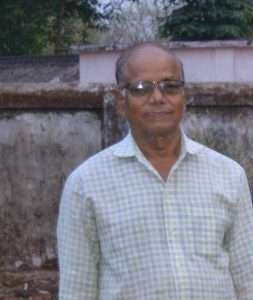 “In-situ seed conservation efforts by individual seed champions and NGOs in India are yet to receive the needed institutional support from agencies involved in Agricultural Research, Development or Policy. This neglect may further accelerate the erosion of genetic diversity that have been protected so far with their efforts.”
“In-situ seed conservation efforts by individual seed champions and NGOs in India are yet to receive the needed institutional support from agencies involved in Agricultural Research, Development or Policy. This neglect may further accelerate the erosion of genetic diversity that have been protected so far with their efforts.”
Shankar Patnaik, Seed Conservationist
Mr Shankar Patnaik is a retired school teacher from Modeigaon village of Kosagumuda block in Nabarangapur, Odisha. Post-retirement, he with his wife Minakshi Devi started collecting, conserving (in-situ), documenting and promoting seeds of indigenous rice varieties without any external help. Shankar has been honoured with the ‘Dr Richaria Samman’ by Odisha Desi Bihana Mancha in 2017 for his contribution towards conservation of indigenous rice.
Mr Patnaik shared his experiences and insights from his efforts at in-situ conservation of indigenous rice varieties with Rasheed Sulaiman V and Nimisha Mittal recently. Excerpts from this interview are given below.
How did it all start?
I retired as a school teacher in 2014. While in service itself I have been involved in rice farming, but I started conservation of indigenous rice varieties post-retirement. I started with six varieties collected from my place (Modeigaon in Kosagumuda block of Nabarangapur district) and later embarked on a journey of collecting seeds of different rice varieties. I began talking to different people in the state who were involved in seed conservation and I also started exchanging seeds of indigenous varieties with other farmers. So, from six varieties in 2014 to 20-25 varieties in 2015, my collection grew to more than 200 varieties by 2016-17. Currently, I have a collection of seeds of 450 indigenous rice varieties.
Meanwhile, I also started experimenting with new high yielding varieties (HYVs) and hybrids of rice promoted in the region and comparing the input costs and net income from these with those of indigenous rice varieties. I found that in most cases the yields are not that different and one can save costs by not applying costly inputs, such as fertilizers, while cultivating indigenous varieties.
So what did you do with the 200 plus collection of seeds?
I cultivated 100 plants of each variety in rows with walking space in between. A 1 metre distance is being maintained between the different varieties to maintain seed purity. The plant-to-plant distance is maintained at 8 cms. These are grown in nursery beds and transplanted. I started noting down the morphological features of these plants, such as number of tillers, height (2 feet to 7 feet), extent of lodging, pollination, duration, colour of grain, yield, etc., and I have compiled a database with all these facts.
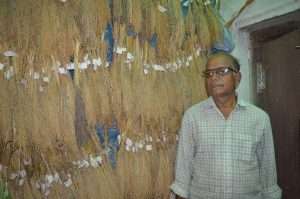 Mr Patnaik in front of his diverse rice varietal collection conserved at home
Mr Patnaik in front of his diverse rice varietal collection conserved at home
Is there a demand for these varieties, and how are the seeds of these varieties shared with other farmers?
People are approaching me seeking varieties with specific traits, for instance, black variety, scented variety, red variety, etc. Additionally, I give them information on colour, duration, yield, etc., for each variety. I have shared different varieties with more than 300 farmers and also sold some of the high-value indigenous rice (Haldichudi, Machhakanta, Kalajeera, Basubhoga, black rice) to different farmers and NGOs.
According to my knowledge there are 200-500 farmers who are cultivating these varieties based on seeds they have collected from me. But I don’t have any information related to what they are doing with these varieties, whether they are conserving or cultivating these. Sometimes people collect small samples, sometimes they buy these seeds and sometimes they exchange seeds with me. For some seeds, there is high demand, like Kalajeera varieties. I sell seeds of these varieties and charge Rs 40/kg for seeds of scented varieties; and for black rice and red rice the seeds are sold at Rs 100/kg.
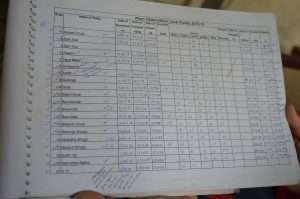 Observation register maintained to capture the morphological characteristic of each variety
Observation register maintained to capture the morphological characteristic of each variety
We have heard many talking about low yields of rice grown with traditional varieties. If it is so, how are you managing rice farming as a profitable enterprise?
Yes, the yield is generally low for rice cultivated with indigenous varieties. The yields are definitely more in the case of HYVs and hybrids. I also grow HYVs and hybrids on half of my 12 acre farm, for selling in the market to earn better income. I have all types of land – low, medium and upland. I have been cultivating CR Dhan, Sahbhagi Dhan and Bina Dhan as there is demand for these grains in the market and the price is high.
But in the rest of my farm I grow indigenous rice varieties. I don’t use any chemical fertilizers. I only add farmyard manure, panchgavya, cowdung cake and gomutra. Cost of cultivation is low in this case. I am keen to grow only indigenous varieties, and from next year I plan to grow scented rice varieties on a large scale by replacing HYVs and hybrids. If good price is available for indigenous varieties, we will definitely grow only these. This time, for Kalajeera I got Rs. 100/kg as price and the yield was 10 quintal per acre and I could earn Rs 1 lakh from this. If we get such prices there is no need to rely on hybrids and we can completely rely on desi varieties.
Some varieties also have medicinal value. For instance, consumption of black rice helps in reducing blood sugar levels and is good for people suffering from diabetes. Rice of scented varieties is in high demand, which can yield up to 17 quintal per acre, and one can grow these without using chemical fertilizers. One can make a good profit from cultivating these varieties, as they fetch high prices in the market.
If the indigenous varieties are so good, why are people still growing HYVs and hybrids?
People are forced to grow modern/HYVs varieties due to the yield potential and the market price, despite knowing that their soils are increasingly getting damaged due to excessive use of chemical fertilizers. Promotion of modern varieties through subsidies and seed kits by the state have accelerated the use of HYVs and hybrids even in areas like Koraput, which is considered to be the main genetic diversity hotspot for rice in India.
There are several indigenous rice varieties that can have higher yields but their potential is not fully explored. Even without application of chemical fertilizers and by maintaining the field with cono weeder, one can get a yield of up to 17 quintal per acre. But, generally people consider these as low yielding varieties and don’t pay much attention. There are many varieties of desi/indigenous rice which have stellar characteristics such as decent weight, good colour, scent, keeping quality, etc. The keeping quality of cooked rice from modern rice varieties is poor – it gets spoilt within a day. But the cooked rice from traditional varieties can be kept for two days without any spoilage and change in scent, taste and colour.
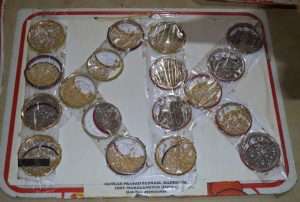 Displaying seeds alphabetically
Displaying seeds alphabetically
You earlier mentioned about some of the limitations of growing HYVs and hybrids. What are these?
Based on my personal experience, I believe the varieties that need higher levels of input application are not good for our environment. With increasing use of chemical fertilizers (that are critical for the HYVs and hybrids for good yields), the soil is becoming hard and there is a considerable dip in its fertility. Before we introduced chemical fertilizers and pesticides, there were small fishes, crabs present in fields which were fed to pregnant women as it was very proteinaceous. People who used to visit rice fields during those times, used to bring home these fishes and crabs for food. If we applied 50 kg of fertilizer this year, we are forced to apply 70 kg of the same fertilizer next year in the same area to maintain the same yield. I got into conservation and sharing of indigenous varieties mainly to address these issues around increasing external input use and its damage to the environment. I am really worried about the rate of soil deterioration that is happening currently, and concerned about what the situation would be 30 years down the line.
According to you, what factors should determine the choice of varieties in rice farming?
For me, the first criterion is long term sustainability of the production system, especially the soil quality. A related element is the quality of water as the water tables are going down and it is getting contaminated with excessive use of chemicals. My second criteria is taste, and I find the cooked rice from indigenous rice varieties very tasty and the smell especially of the scented varieties is quite good. My third criteria is cost of cultivation and I find growing indigenous rice varieties helps in reducing the cost of cultivation. This is so because seeds of indigenous varieties are often available with you and you can often exchange it with other farmers in the vicinity/the community and also save on use of chemical fertilizers.
This is not to say that yield is not a criterion at all. But it depends upon your goals in farming. But a lot could be done to enhance the yield and income from growing indigenous varieties. For instance, through promoting seed purity of indigenous varieties and developing value chains for indigenous varieties, which unfortunately hasn’t really got the attention of policy makers.
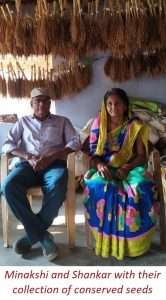 Why is there very little effort in promoting in situ conservation of rice varieties on the lines of what you are doing currently?
Why is there very little effort in promoting in situ conservation of rice varieties on the lines of what you are doing currently?
I really do not know the reason. I believe everyone is going after raising yields and introducing new varieties. I am not part of that race. For me conserving the genetic diversity in-situ and making these seeds accessible to all those who can grow indigenous rice varieties, is important for our survival. We have already lost a number of varieties and with more areas coming under modern varieties we are losing the rich diversity of our rice varieties quite rapidly.
I currently conserve more than 400 varieties and I am keen to partner with others who are interested in conserving and promoting these seeds among farmers. I have brought several varieties from other places and cultivated them here. Some will grow well, some will grow very tall, some will grow short, etc. Overall, it takes time for adaptation. I want to promote change at my level, however small it might be, and I hope individuals and organisations working in the rice sector will recognize the importance of efforts made by people like me who are trying to conserve and promote our diverse indigenous rice seeds out of passion and without any external support.
What needs to be done to really promote in-situ conservation and promotion of indigenous varieties?
Firstly, there is a need to bring about awareness on the importance of in-situ conservation of indigenous varieties, as otherwise it will all get lost. As discussed earlier, there are several advantages of growing indigenous varieties, especially in terms of protecting the environment and reduction in costs.
Many of these indigenous varieties can tolerate both abiotic and biotic stress much better than the modern varieties. For instance, if there is heavy wind or rain, there will be complete loss in the case of modern varieties, but not in the case of indigenous varieties. In other words, the risk margin is very low in the case of indigenous varieties. Similarly, the indigenous varieties can better tolerate infestation of Brown Plant Hopper (BPH) whereas there will be complete wipe out of modern varieties which I have seen in my own fields in 2018.
Secondly, efforts should be made to develop markets for rice produced from indigenous varieties. Many of these have several nutritive and health benefits and special features like scent and taste. However, this needs to be tested, validated and supported by science. So, more research by scientists on understanding the traits of these varieties is needed, not merely for mapping the traits but for promoting the cultivation and uptake of these varieties by more people. So even if yields are relatively low, farmers can earn a better income from cultivation of indigenous varieties.
Thirdly, all the different stakeholders in the rice sector should also see how they can support the farmers cultivating indigenous varieties as well as farmer groups and NGOs supporting in-situ conservation of rice. Currently almost all efforts in the name of supporting rice farmers is around promoting HYVs and hybrid rice. We need to have an ecosystem supporting in-situ conservation beyond awarding seed conservationists and registration of farmer varieties.
Acknowledgement: This interview was done as part of the STRINGS (Steering Research and Innovation for Global Goals) Project (http://strings.org.uk/), where CRISP is undertaking a case study on how alternative STI pathways involved in supporting rice farmers to better adapt to climate change are contributing to SDGs. Our special thanks to Pragati Koraput (https://pragatikoraput.org/) for their operational support and guidance in organising this interview.

Dr Rasheed Sulaiman V is Director, Centre for Research on Innovation and Science Policy (CRISP), Hyderabad, India. You can reach him at rasheed.sulaiman@gmail.com

Ms Nimisha Mittal is Lead Researcher, Centre for Research on Innovation and Science Policy (CRISP), Hyderabad, India. You can reach her at nimisha61@gmail.com

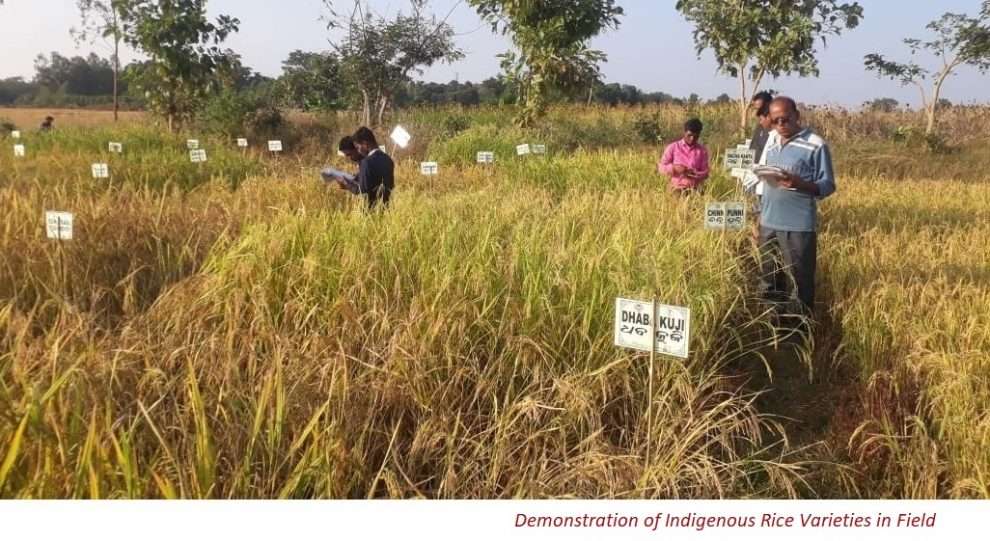



Add Comment